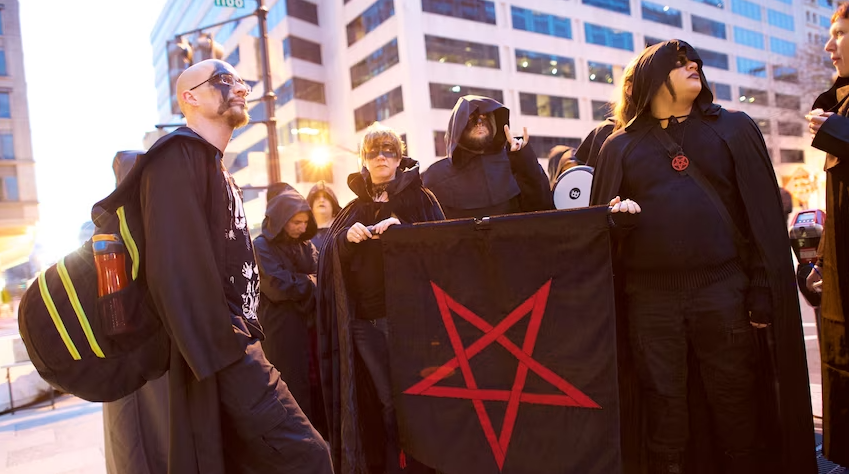News
Satanism in America: Unveiling the Myths and Realities

Satanism in America is a topic shrouded in mystery, controversy, and often, misunderstanding. From its historical roots to its modern-day manifestations, Satanism has evolved significantly, influencing and being influenced by various cultural and social dynamics. This article explores the history, beliefs, and practices of Satanism in America, and examines its alleged connections with the Illuminati.
Historical Roots of Satanism in America
The concept of Satan has ancient origins, but the organized practice of Satanism as we know it today began in the 20th century Anton LaVey founded the Church of Satan in 1966 in San Francisco, marking a significant milestone in the history of modern Satanism. LaVey’s version of Satanism was more about self-empowerment and individualism than worshiping a literal devil. His publication, “The Satanic Bible,” laid the foundation for the beliefs and practices of the Church of Satan.
The Satanic Panic of the 1980s and 1990s
In the 1980s and 1990s, America experienced a period known as the Satanic Panic. This was a time of widespread fear and moral panic over alleged Satanic ritual abuse, which led to numerous false accusations and convictions. The media played a significant role in fueling these fears, often sensationalizing stories without substantial evidence. The panic has since been largely debunked, but it left a lasting impact on public perception of Satanism.
The Rise of The Satanic Temple

Founded in 2013, The Satanic Temple (TST) has become one of the most prominent Satanic organizations in the United States. Unlike the Church of Satan, TST is more politically active and uses Satanic imagery to advocate for secularism and social justice. They do not believe in a literal Satan but use the figure as a symbol of rebellion against arbitrary authority. TST’s activities include legal battles for religious freedom, public demonstrations, and community outreach programs.
Beliefs and Practices of Modern Satanism
Modern Satanism is diverse, but some common themes include:
- Individualism: Emphasizing personal freedom and self-expression.
- Rationalism: Valuing science and reason over superstition.
- Symbolism: Using Satanic imagery to challenge traditional religious norms.
The Alleged Connection with the Illuminati
The Illuminati is often mentioned in the same breath as Satanism, largely due to conspiracy theories that link the two. The Illuminati was a real secret society founded in 1776 in Bavaria, but it was disbanded in the late 18th century. Modern conspiracy theories suggest that the Illuminati continues to exist and exerts control over global events, often associating it with Satanic rituals and symbolism.
However, there is no credible evidence to support these claims. The Church of Satan and The Satanic Temple have both publicly distanced themselves from the Illuminati, emphasizing that their beliefs and practices are not connected to any secret society. The association between Satanism and the Illuminati is largely a product of sensationalist media and imaginative conspiracy theories.
Public Perception and Controversy
Satanism often faces misunderstanding and hostility, particularly from religious groups. Events like SatanCon, organized by The Satanic Temple, draw both interest and protest. Despite this, many Satanists advocate for religious freedom and respect for all beliefs. The use of Satanic imagery and rituals is often seen as blasphemous by Christians, but for Satanists, it is a form of symbolic rebellion and a way to challenge societal norms.
The Role of Media and Pop Culture
Media and pop culture have played significant roles in shaping public perception of Satanism. Movies, TV shows, and music often depict Satanism in a sensationalist manner, contributing to the myths and misconceptions surrounding the practice. High-profile performances by artists like Beyoncé and Sam Smith have been accused of promoting Satanic imagery, further fueling conspiracy theories.
The Impact of Satanism on American Society
Despite the controversies, Satanism has had a notable impact on American society. It has challenged traditional religious norms, advocated for individual rights, and promoted secularism. The legal battles fought by The Satanic Temple have highlighted issues of religious freedom and the separation of church and state, contributing to broader discussions about the role of religion in public life.
Conclusion
Satanism in America is a complex and evolving movement. From its roots in the 1960s with the Church of Satan to the politically active Satanic Temple, it continues to challenge societal norms and advocate for individual rights. The alleged connections with the Illuminati are largely unfounded and serve more as a reflection of society’s fascination with secret societies and conspiracy theories. Understanding the history and diversity of Satanism can help demystify this often misunderstood belief system and promote a more nuanced view of its role in contemporary society.
FAQs
1. What is the history of Satanism in America?
Satanism in America began with the founding of the Church of Satan by Anton LaVey in 1966. The Satanic Panic of the 1980s and 1990s brought it into the public eye, often through sensationalist claims.
2. How is Satanism connected to the Illuminati?
The connection is largely based on conspiracy theories. The Illuminati was a real secret society disbanded in the late 18th century. Modern Satanic organizations like the Church of Satan and The Satanic Temple have no ties to the Illuminati.
3. What are the beliefs and practices of modern Satanism?
Modern Satanism emphasizes:
- Individualism: Personal freedom and self-expression.
- Rationalism: Valuing science and reason.
- Symbolism: Using Satanic imagery to challenge traditional norms.
News
The Tragic Case of Manling Williams: A Family Torn Apart by a Mother’s Betrayal

Manling Williams, born as Manling Tsang in 1979, endured a childhood marked by significant challenges. Affectionately called “Ling” by those close to her, she struggled academically due to various learning disabilities. These challenges impacted her confidence and ability to form a traditional educational path, shaping the trajectory of her life. Despite these setbacks, Manling displayed a determined spirit and pursued opportunities to build a stable future for herself.
Raised in California, Manling’s early years painted a picture of a typical suburban childhood, yet the difficulties she faced in school often left her feeling isolated. Friends and acquaintances described her as both soft-spoken and hardworking, qualities that she would later leverage in her adult life. However, hidden beneath her surface demeanor were unresolved issues and personal struggles that would later culminate in devastating actions.
Family Dynamics: A Loving Husband and Two Precious Sons
Manling’s marriage to Neal Williams seemed, on the surface, like the foundation of a happy family. Neal, a devoted husband and father, had chosen to stay at home to raise their two young sons, Devon and Ian. His days were spent nurturing the children and indulging in his passion for collecting swords, an interest that reflected his calm and reflective nature. Manling, meanwhile, served as the primary breadwinner, balancing work responsibilities with the demands of parenting.
The couple’s sons, Devon 7 years old, and Ian 3 years old, were described as bright and loving children, full of energy and curiosity. The Williams family’s life in Rowland Heights, California, appeared idyllic to neighbors and friends. Yet, beneath the façade, cracks in the marriage began to form, fueled by financial strain, personal dissatisfaction, and unspoken tensions.

The Crime That Shattered a Community
On the morning of August 7, 2007, Manling claimed to have returned home around 7:30 a.m. from a shopping trip to discover a horrific scene. According to her account, Neal was gravely injured, and their two sons were unresponsive. She ran from the house screaming for help, her cries drawing the attention of shocked neighbors.
When police arrived, they uncovered a gruesome crime. Neal had been savagely attacked, suffering over 90 stab wounds inflicted by a samurai sword from his own collection. The couple’s sons had been smothered to death with a pillow in their beds, their young lives stolen in an act of unimaginable cruelty. The brutality of the murders sent shockwaves through the Rowland Heights community, leaving residents in disbelief that such violence could occur within a seemingly peaceful household.
Unraveling the Truth: Motives Behind the Tragedy
As investigators delved deeper into the case, the narrative presented by Manling began to unravel. While she initially portrayed herself as a grieving wife and mother, inconsistencies in her story raised suspicions. Forensic evidence contradicted her account of events, and it soon became clear that she was not the helpless victim she claimed to be.
During questioning, Manling confessed to the murders, revealing a disturbing motive. Reports suggested she was overwhelmed by the responsibilities of family life and sought an escape from her marriage and parental obligations. Additionally, she had reconnected with an old flame and fantasized about starting a new life free of the burdens she perceived in her current situation. This desire for liberation, combined with her emotional instability, led her to commit an act of betrayal against those closest to her.

The Trial and Justice Served
Manling Williams’ trial became a focal point of national attention, with prosecutors emphasizing the premeditated nature of her actions. The sheer brutality of Neal’s murder and the calculated smothering of her sons painted a picture of a deeply troubled individual willing to destroy her family to achieve personal freedom.
In 2011, after four years of legal proceedings, Manling was convicted of three counts of first-degree murder. The jury recommended the death penalty, citing the heinous and deliberate nature of her crimes. She is currently incarcerated on death row at the Central California Women’s Facility in Chowchilla, awaiting the final resolution of her sentence. For many, her conviction brought a measure of justice, though the loss of Neal, Devon, and Ian remains an unhealable wound for their extended family and friends.
Legacy of Pain and Lessons Learned
The case of Manling Williams serves as a stark reminder of the importance of addressing mental health and familial struggles before they escalate into tragedy. Her actions were not only a betrayal of her husband and children but also a breach of the societal trust that holds families together.
Neighbors, friends, and extended family members who knew the Williams family continue to grapple with the shock of what transpired. The Rowland Heights community, once defined by its tranquility, was left to mourn the loss of innocence that accompanied the horrific murders.
Conclusion
Manling Williams’ story is one of profound tragedy—a tale of unmet emotional needs, personal turmoil, and irrevocable choices that destroyed a family. While justice was served in the legal system, the scars left by her actions remain etched in the hearts of those who knew Neal and the boys. The case underscores the importance of open communication within families, early intervention for mental health struggles, and the role of communities in supporting individuals who may be at risk of causing harm.
FAQs
What led Manling Williams to commit the murders?
Manling Williams cited feelings of being trapped in her marriage and overwhelmed by parental responsibilities as her motives. She had also reconnected with an old flame and fantasized about starting a new life without her family.
What were Neal Williams’ interests and role in the family?
Neal Williams was a stay-at-home father who devoted himself to raising their two sons. He was also passionate about collecting swords, a hobby he indulged in while caring for the children.
How were the murders carried out?
Neal was stabbed over 90 times with a samurai sword from his own collection. The couple’s sons, Devon and Ian, were smothered with a pillow in their beds.
What was Manling Williams’ sentence?
In 2011, Manling Williams was convicted of three counts of first-degree murder and sentenced to death. She is currently on death row in California.
How did the community react to the tragedy?
The Rowland Heights community was shocked and devastated by the murders. Neighbors and friends who knew the family struggled to reconcile the brutality of the crimes with their perception of Manling as a caring wife and mother.
What can be learned from this case?
The case highlights the need for addressing mental health issues, improving communication within families, and providing support for individuals facing emotional crises before they escalate into violence.
News
The Tragic Murder of Tiffany Pugh: A Chilling Murder-for-Hire Case

The murder of Tiffany Pugh in 2014 shook the East Point, Georgia community to its core. The chilling plot, masterminded by her husband, Andre Pugh, also known as DJ Awesome, revealed a horrifying tale of betrayal, greed, and violence. This tragic case not only ended a life but also left behind scars that lingered for years.
The Life of Tiffany Pugh: A Loving Wife and Mother
Tiffany Pugh was known as a devoted wife and loving mother. At the time of her tragic death, Tiffany was married to Andre Pugh, a popular Atlanta DJ who worked under the moniker DJ Awesome. The couple shared a seemingly happy life on the surface, but beneath the facade lay cracks that would ultimately lead to her untimely demise.
In her early thirties, Tiffany was building her life while supporting her husband’s growing career in Atlanta’s entertainment industry. Friends and family described her as warm-hearted, dedicated, and always focused on providing a stable home for her family.
However, marital troubles began to emerge as Andre’s career blossomed. Allegedly, financial stress and infidelity strained their relationship, creating a toxic dynamic. While Tiffany sought solutions to mend their bond, Andre was plotting a horrifying end to their marriage.

The Mastermind Behind the Plot: DJ Awesome
Andre Pugh, a well-known DJ in Atlanta’s nightlife, worked regularly at some of the city’s most prominent strip clubs. His stage name, DJ Awesome, was synonymous with vibrant music and late-night entertainment. Yet behind the turntables, Andre lived a life marred by debt and questionable decisions.
By 2014, Andre’s financial problems had spiraled out of control. Reports suggest he saw his wife, Tiffany, as a financial burden, particularly as tensions over money and infidelity grew. Instead of seeking a divorce, Andre devised a sinister plan: to have Tiffany killed.
Andre enlisted his best friend, Adrian Harley, to execute the heinous crime. Adrian’s loyalty to Andre, coupled with a promise of financial compensation, drove him to carry out the murder-for-hire plot that would shock the nation.
The Day of the Crime: A Chilling Execution
On the morning of August 16, 2014, Adrian Harley entered Tiffany’s East Point home under the guise of familiarity, as he was well-known to the Pugh family. Armed and with clear intent, Adrian shot Tiffany multiple times, leaving her lifeless in her home. The scene was one of sheer brutality, marked by betrayal and violence.
Neighbors and law enforcement were horrified by the nature of the crime. Initial investigations didn’t immediately point to Adrian, but within weeks, police uncovered the chilling conspiracy that linked him and Andre to the murder.
Phone records, financial documents, and witness testimony painted a damning picture of Andre’s involvement. His financial distress, combined with mounting marital woes, made Tiffany a target in a diabolical plan aimed at resolving his problems.

The Arrest and Legal Proceedings
The evidence against both Adrian Harley and Andre Pugh was overwhelming. Authorities swiftly charged Adrian with first-degree murder, while Andre faced charges of conspiracy to commit murder.
Prosecutors presented a harrowing case, detailing the premeditated nature of the crime. The murder-for-hire scheme was laid bare, with Adrian’s role as the triggerman and Andre’s orchestration of the plot leaving no room for doubt.
In court, Andre’s demeanor revealed little remorse, further fueling public outrage. Family members of Tiffany, including her devastated relatives, spoke out about the unimaginable pain of losing her to such a cruel and calculated act.
Ultimately, both men were convicted and sentenced to lengthy prison terms. The court’s verdict brought some measure of justice, but the void left by Tiffany’s death remained immeasurable.
The Impact on Family and Community
Tiffany’s murder not only devastated her immediate family but also rippled through the broader East Point community. Friends and neighbors were stunned by the betrayal that led to her death.
Her children, robbed of a mother’s love and guidance, became the most profound victims of the tragedy. They faced a lifetime of healing from the scars left by their father’s betrayal and the loss of their mother.
The case also sparked conversations about domestic violence, financial abuse, and the warning signs of toxic relationships. Advocates emphasized the importance of seeking help when relationships turn volatile, urging communities to be vigilant in supporting those in danger.

Lessons Learned from a Tragic Case
The murder of Tiffany Pugh serves as a somber reminder of the consequences of unchecked greed, betrayal, and violence. Her case underscores several critical lessons:
- Recognizing warning signs: Financial and marital problems, coupled with controlling behavior, often escalate if left unaddressed.
- Seeking help: In volatile relationships, individuals should prioritize their safety and seek support from family, friends, or professional resources.
- The value of community awareness: Engaged communities can play a crucial role in identifying and preventing domestic tragedies before they escalate.
While Tiffany’s life was tragically cut short, her story continues to resonate as a cautionary tale for others.
Conclusion
The murder-for-hire plot that claimed Tiffany Pugh’s life remains one of the most heartbreaking crimes in recent memory. Her husband, Andre Pugh, and his best friend, Adrian Harley, conspired to take her life over financial and marital discord, leaving a permanent mark of pain and loss on her family and community.
Though justice was served, it cannot undo the profound loss suffered by Tiffany’s loved ones. Her case stands as a poignant reminder of the need for vigilance, support, and intervention in troubled relationships.
FAQs
Who was Tiffany Pugh?
Tiffany Pugh was a wife and mother living in East Point, Georgia. She was married to Andre Pugh, a popular DJ in Atlanta known as DJ Awesome.
Why was Tiffany Pugh murdered?
Tiffany was murdered in a murder-for-hire plot orchestrated by her husband, Andre Pugh. The motive stemmed from financial and marital issues.
Who committed the murder?
Adrian Harley, Andre Pugh’s best friend, carried out the murder at Andre’s request. He shot Tiffany in her home on August 16, 2014.
What happened to Andre Pugh and Adrian Harley?
Both were convicted for their roles in the murder. Andre faced charges of conspiracy to commit murder, and Adrian was charged with first-degree murder. Both received lengthy prison sentences.
What lessons can be learned from this case?
The case highlights the importance of addressing financial and marital problems constructively, recognizing warning signs in relationships, and seeking help before situations escalate.
How has the case impacted the community?
The East Point community and Tiffany’s family were deeply affected by the tragedy. It raised awareness about domestic violence and the importance of intervention in toxic relationships.
News
Mindy Mann: Nanny in the Spotlight, Gavin Rossdale Affair, and Her Life Story

Mindy Mann, an Australian native, became a household name under controversial circumstances. Working as a nanny for one of Hollywood’s most talked-about couples, Gwen Stefani and Gavin Rossdale, Mann’s name entered the spotlight when allegations of an affair between her and Rossdale emerged. These claims rocked the entertainment industry, causing the eventual split of the celebrity duo who had been married for over a decade.
Before her connection to fame and controversy, Mindy Mann led a relatively low-profile life. Known for her vibrant personality and affinity for fitness and childcare, she was hired by Stefani and Rossdale to care for their three children. While her life before the scandal remains largely under wraps, Mann’s involvement in the high-profile marriage has forever etched her name into the annals of celebrity gossip.
Mindy Mann’s Career and Role as a Nanny
Mindy Mann built a career around childcare, earning a reputation for being an energetic and engaging nanny. Her experience working with children, coupled with her fitness-oriented lifestyle, made her an attractive choice for high-profile families like Gwen Stefani and Gavin Rossdale.
The family reportedly trusted Mann with their three children: Kingston, Zuma, and Apollo. She was deeply involved in the children’s day-to-day activities, often accompanying them on family outings and being a fixture in their household. Photos from that period often showed Mann with the family, appearing to fit seamlessly into their dynamic.
However, cracks began to appear in her seemingly professional role. Reports claimed that Mann’s behavior mirrored Gwen Stefani’s in an uncanny manner—allegedly copying Stefani’s fashion sense and even her mannerisms. While initially dismissed as coincidence, these similarities later gained new meaning when the affair allegations surfaced, causing fans and insiders to reevaluate Mann’s time with the family.

The Alleged Affair with Gavin Rossdale
Mindy Mann became infamous in 2015 when rumors of her affair with Gavin Rossdale came to light. Sources alleged that the affair had spanned three years, occurring during a critical period in Rossdale and Stefani’s marriage.
The claims reportedly came to Gwen Stefani’s attention through the family’s former nanny, who discovered inappropriate text messages and photos on the family iPad. These revelations were devastating, leading to a confrontation that resulted in Rossdale eventually admitting to the affair after initially denying the allegations.
This betrayal marked the beginning of the end for Stefani and Rossdale’s marriage. The couple, who had been together for over 13 years and shared a significant public and private life, officially filed for divorce in 2015. While Rossdale maintained a relatively low profile about the accusations, the scandal firmly placed Mann at the center of a media storm.
Mindy Mann’s Life After the Scandal
Following the affair’s exposure, Mindy Mann retreated from the public eye. Though she attempted to maintain a private life, the scandal’s fallout made anonymity nearly impossible.
In the years since, reports have surfaced about Mann focusing on her career in childcare and fitness, continuing to work in roles unrelated to her past controversy. She also welcomed a child of her own, signaling a new chapter in her personal life. However, her name remains synonymous with one of Hollywood’s most infamous nanny scandals.

Her relationship with Gavin Rossdale after the affair ended remains unclear. Public records and insider reports suggest the connection was severed after the allegations became public, leaving Mann to rebuild her life outside of the media’s constant scrutiny.
Family and Personal Life
Despite the public drama surrounding her, little is known about Mindy Mann’s family or upbringing. Born and raised in Australia, she has largely avoided interviews or public statements about her private life.
Mann reportedly embraced a quieter life following the scandal, focusing on her role as a mother and fitness enthusiast. Her family life now appears to be her primary focus, far removed from the tabloid headlines that once dominated her existence.
Though her role as a nanny placed her squarely in the lives of Hollywood royalty, Mann’s personal narrative reflects a return to normalcy—albeit under the lingering shadow of controversy.
Gavin Rossdale and Mindy Mann: The Legacy of a Scandal
The alleged affair between Gavin Rossdale and Mindy Mann had lasting implications not just for them but for those around them. Gwen Stefani, in particular, has spoken about the emotional toll of the discovery, later channeling her feelings into her music. The divorce settlement between Stefani and Rossdale involved significant financial and custodial negotiations, further cementing the affair’s impact on their family.
For Rossdale, the scandal tarnished his reputation, with many fans viewing him in a negative light. Despite this, he continued to pursue his career in music and remained active in co-parenting his children with Stefani.

Mindy Mann’s involvement in this chapter of Hollywood history serves as a cautionary tale about the intersection of private lives and public scrutiny. While Rossdale and Stefani have moved on—Stefani now married to country music star Blake Shelton—Mann’s name remains a key part of their narrative.
Conclusion
Mindy Mann’s rise to infamy serves as a striking example of how private choices can have far-reaching public consequences. Her alleged affair with Gavin Rossdale not only altered her own life but played a pivotal role in the dissolution of one of Hollywood’s most beloved couples.
Today, Mann leads a quieter life, far removed from the scandal that once defined her public image. Though her name is forever linked to the Rossdale-Stefani breakup, her story also reflects the complexities of fame, trust, and human relationships in the spotlight.
FAQs
1. Who is Mindy Mann?
Mindy Mann is an Australian childcare professional and former nanny who gained notoriety for her alleged affair with musician Gavin Rossdale while working for him and Gwen Stefani.
2. What was Mindy Mann’s role in Gavin Rossdale and Gwen Stefani’s split?
Mann’s alleged three-year affair with Gavin Rossdale reportedly caused the breakdown of his marriage to Gwen Stefani, leading to their divorce in 2015.
3. What is Mindy Mann doing now?
Since the scandal, Mindy Mann has largely retreated from public life. She has reportedly continued working in childcare and fitness and is now a mother herself.
4. Did Gavin Rossdale confirm the affair with Mindy Mann?
Reports suggest Rossdale initially denied the allegations but later admitted to the affair, leading to the eventual dissolution of his marriage to Gwen Stefani.
5. How did Gwen Stefani react to the scandal?
Gwen Stefani was devastated by the revelations, which deeply affected her personally and professionally. She has since moved on and is now married to Blake Shelton.
6. Did Mindy Mann speak out about the allegations?
Mindy Mann has never publicly commented on the affair allegations, maintaining a low profile and avoiding media attention.
-

 Celebrity5 months ago
Celebrity5 months agoBailey Zimmerman’s Net Worth in 2024: A Look at His Earnings
-

 Business7 months ago
Business7 months agoIs Bolt Cheaper Than Uber? Comparing Ride-Hailing Prices and Services
-

 Celebrity6 months ago
Celebrity6 months agoWho Is Charlotte Tilbury: The Visionary Behind a Global Beauty Empire
-

 Celebrity6 months ago
Celebrity6 months agoJohn Summit Net Worth: A Rising Star in the Music Industry
-

 Celebrity4 months ago
Celebrity4 months agoExploring the Life of Andrew Shingange: Trevor Noah’s Brother and an Advocate for Change
-

 Celebrity4 months ago
Celebrity4 months agoCaseOh’s Financial Success in 2024: Net Worth, Income Streams & More
-

 Celebrity5 months ago
Celebrity5 months agoWho Is Josh Winterhalt? All About His Net Worth, Wife Sarah Wayne Callies, and Marriage
-

 Celebrity5 months ago
Celebrity5 months agoJamie Apody Net Worth, Biography, Age, Husband, and Career Journey




